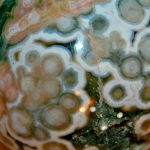Gemstones
Gemstones: beautiful, extremely rare and remarkably durable! To most of us they are much, much more than perfectly formed minerals. Through their mysterious sparkle and luminously enchanting hues, gemstones signify life-long promises, inspire colorful dreams and tie generations together. Formed over millions of years, under the most fiery and tumultuous conditions this world has ever known, a gemstone truly is one of Nature’s purest little miracles!
Chace & Abbott has compiled an assortment, listed below, of the most well-known, noteworthy and classic gemstones. Are you curious about a rarity like benitoite or simply don’t see your favorite on the list? Just ask! Our Graduate Gemologist surely has knowledge to share with you, and may just introduce you to your newest jewelry passion…

A cousin of Sunstone and Labradorite, Amazonite’s color ranges from a beautiful seafoam green to a vibrant deep teal blue. Owing its name to an ancient Amazonian warrior-women legend, Amazonite encourages self-assuredness, grace and confidence.

One of nature’s organic treasures, the Abalone mollusk produces mother-of-pearl shell in iridescent swirls of green, blue and violet, as shimmering and mesmerizing as the sea itself. Perhaps man-kind’s first true adornment, Abalone Shell enhances the tides and harmony of human relationships, and closely connects the wearer to the cycles of the oceans. New Zealand’s exotic coastal waters remain the world’s most famous source.

Believed by the ancient Greeks to be solidified drops of golden sunshine, Amber is 30 -100 million year old fossilized tree resin. A natural time capsule, Amber trapped insects, bubbles and plant material, providing amazing windows into our Earth’s past. Amber has electromagnetic properties, floats in saltwater and is reputed to strengthen mental clarity and help alleviate exhaustion.

Found in 1834 in Russia and named after Czar Alexander II, this birthstone for June is a true rarity. A color-changing stone (often from bluish-green to purplish-red depending on the light source), natural alexandrite is known as an “emerald by day & ruby by night”. Alexandrite is believed to increase self-esteem and bring increased spiritual love and joy to the wearer.

The most popular member of the Quartz family, Amethyst is February’s birthstone and the gemstone for the 6th wedding anniversary. Named after the Greek word “amethystos”, meaning “not to intoxicate”, Amethyst was believed to ward off drunkenness and has long been associated with the Greek god Bacchus. Historically found in Brazil, Amethyst’s lilac to rich violet-purple color is believed to soothe the soul, calm anxieties and control passions.

Slowly gaining in popularity, this little-known gemstone is often found in shades of yellow, green and blue. It was named after the Greek word “apate” which means “deceit”. Useful for more than its beauty, Apatite is rich in phosphorous.

A beautiful sultry blue cousin of Emerald and Morganite, Aquamarine is March’s primary birthstone. Named for the Latin word for “sea water”, legend claims that mermaids left shimmering crystals on the shores for sea-farers as tokens of luck and safe passage. Brazil is famed as the most prolific source. This extraordinary greenish-blue gemstones that are said to calm restlessness and release anxieties.

Agates, a banded variety of Chalcedony, most often are found in shades of red, orange, yellow and brown. The popular soothing baby-blue variety conjures feelings of serenity, patience and peace. Whether a small tumbled trinket, or uniquely striped polished beads, you can be certain that no two pieces are exactly alike.

According to ancient traditions, this bright and fiery Chalcedony is believed to stimulate passions and enhance physical energies. It’s no wonder, ranging from yellowish-orange to orangish-red, that Carnelian is a perennial favorite of outgoing, assertive, fun-loving individuals. Carnelian will add a little sunshiny exuberance to your day.

One of Chace & Abbott’s true favorites. This gorgeous, velvety lilac-purple mineral displays remarkable patterns, accented by stunning white and black veins. Named for the Russian word “charo” meaning “beautiful”, charoite is believed to lift our spirits and open our hearts to new possibilities.

Sometimes called “Queensland Jade”, due to its often Australian pedigree and its resemblance to fine Burmese Jade, Chrysoprase is a bright “jelly bean” green variety of Chalcedony. Mostly found as polished cabochons, it is said that Frederick the Great (the 18th century King of Prussia) preferred Chrysoprase to any other stone. It’s believed that the wearer gains self-confidence and wisdom while adorned in this vivid green gem.

Named after the French word “citron”, meaning “lemon”, Citrine is a sunshiny yellowish-orange variety of Quartz. Alternating with the relatively rare Imperial Topaz, Citrine is the birthstone for November and is recognized as the gemstone for the 13th wedding anniversary. Citrine is thought to reduce anxieties, lessen the effects of food allergies and strengthen one’s willpower.

An organic beauty and made of tiny marine organisms, Coral is found in colors ranging from “ox-blood” red to peach, deep pink to white, and occasionally even purple, black and golden-brown. Highly cherished in ancient India, Persia and Rome, Conservation efforts, including strict harvesting regulations, are helping to ensure that this ocean treasure will be enjoyed for generations to come.

The one stone that needs no introduction, Diamonds are the most brilliantly radiant, popular and well-known of all gemstones. Named for the Greek word “adamas”, meaning “invincible” and now the symbol of true love. Historically believed to protect the wearer against poison, fire, black magic and illness. Have enough brilliant white? Expand your horizons and look for Diamonds in brown, yellow, black, pink and blue!

Diopside, a little-known stone, proves that it isn’t easy being green. Often overshadowed by Emerald and Tsavorite Garnet, Diopside should be considered for its clear, deep-green chrome Diopside Although Chace & Abbott only occasionally carries Diopside, it warrants consideration because the stone can also be found in near-black cabochons that display 4-rayed stars and cat’s-eyes. Diopside signifies trust and humbleness and helps to enhance love and commitment

The illustrious, vibrant green member of the Beryl family, Emerald is the birthstone for May and represents the 20th and 35th wedding anniversaries. The fabled Cleopatra Mines date back to 1500 B.C., and it is said that Caesar stockpiled the verdant, fertile-colored beauties for their supposed healing powers.

Named after the Latin word “fluere”, meaning “to flow”, Fluorite has been used in carvings since ancient Roman times. The stone’s amazing color variety is as enchanting as a rainbow. Pastel to vivid purples, blues and greens are most often found, while occasional rose-red stones are uncovered. Used as a key ingredient to prevent tooth decay, Fluorite is believed to relieve anxiety and insomnia while enhancing one’s focus.

Garnets, collectively grouped into a “family” of minerals, are January’s birthstone, the gemstone for the 2nd wedding anniversary. Originally named after red pomegranate seeds, Garnets are found in every color but rarely in blue. Choose your favorite color: deep red Almandite and Pyrope, purplish Rhodolite, orange Spessartite, lime Andradite or green Tsavorite. No matter the color, Garnets symbolize friendship and loyalty and enhance confidence.

Gaspeite is a relatively rare, opaque, lively, apple-green mineral. Found only in Canada and Australia, aboriginal people believe Gaspeite brings good luck and eases the fears of its wearer. A soft mineral, Gaspeite is most often found as cabochons and beads, and mixes well with Turquoise, Coral, Sugilite and Lapis.

Once believed to be ‘premature’ or ‘baby’ black diamond due to its shiny luster, Hematite is a silvery-black metallic mineral. Hematite’s reddish (rusty) pigment is famously preserved in France’s Lascaux cave paintings. Hematite is thought to calm hysteria, induce restful sleep and increase concentration and memory.

High on Chace & Abbott’s list of favorites, blue-violet Iolite is often called “water-sapphire”. Possessing an unusual characteristic called “trichroism”, Iolite displays 3 different colors – blue, violet and brown- when viewed from 3 different directions. Iolite is believed to enhance imagery and peaceful thoughts and reveal truths.

Jade represents 5 major virtues – charity, courage, justice, modesty and wisdom. Used since the Stone Age for its tremendous toughness, the most sought-after color of Jade is an intense, medium “Imperial” green. Jade’s wearer is said to possess a steady inner strength and emotional balance, and to display generosity, peacefulness and love.

Jasper, the opaque variety of Chalcedony, is found in a myriad of colorful hues. Traditionally, Bloodstone is deep green with red dots and Red Jasper have been the most popular choices. A new discovery in Madagascar unearthed Ocean Jasper which is characterized by mesmerizing spherical patterns in peach, orange, white, yellow, green, brown and black. It’s believed to help heal stomach ailments and to keep the wearer grounded and mentally strong.

Ranging from soft lime green to gray to deep sapphire blue, despite Kyanite’s beautiful range of color, it remains a relatively little-known gemstone due to its softness and fragile cleavage planes. Higher quality stones and improved cutting techniques are insuring that stunning beads and faceted stones can be worn by those seeking tranquility, clarity and increased self-awareness.

A close cousin of Moonstone and Sunstone, Labradorite is the almost-metallic, iridescent variety of the Feldspar group of minerals. Possessing the phenomenon “labradorescence”, Labradorite flashes colors ranging from blue to green, gold to orange and occasionally pink and purple. Stones with flashes of blue and green are believed to induce more restful sleep, while those Labradorites with flashes of gold and orange energize and invigorate the wearer.

Mined and adored by the ancient Egyptians and used as pigment in paint for centuries in Europe, Lapis Lazuli is one of the world’s most historically significant gemstones. Often speckled with gold-colored Pyrite and white Calcite, the finest quality Lapis is found in Afghanistan and is a royal azure blue. Due to its soothing, relaxing blue hue, Lapis is believed to ease restlessness, cure insomnia and increase the wearer’s intuition.

Originally discovered in 1916, in the Dominican Republic, natives believed these Caribbean Sea-colored stones came from the ocean, and it’s easy to see why! Larimar owes it’s blue color to copper, but be careful with it – it’s photosensitive - meaning that it will fade over time if exposed to too much light & heat.

Malachite is a beautiful, uniquely patterned, opaque, intense green mineral. Named after the Greek word “malakhe”, meaning the herb “mallow”. Colored by copper, Malachite can be found in copper ore deposits around the globe. From ancient Egypt to czarist Russia, and from imperial China to the present day Zimbabwe, Malachite has been sought after as beautiful carving material and is believed to increase energy.

A newcomer to the Jasper family, Mookaite is found in Western Australia. Amazing ‘autumn color’ combinations of yellow, red, maroon, pink, brown, mauve and purple distinguish this Jasper from all others. It’s believe Mookaite helps connect the wearer to loved ones who’ve passed away and shields the wearer from difficult situations.

Moonstone, a birthstone for June, is a close cousin of Amazonite and Labradorite in the Feldspar family. Found in shades of gray, brown, yellow, orange, white and occasionally green, Moonstone often possesses the phenomenon known as adularescence – a billowy, luminous light seemingly coming from within the stone. Moonstone is believed to drive away sleeplessness, to enhance intuitions and to connect the wearer with the moon and other heavenly bodies.
